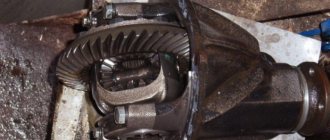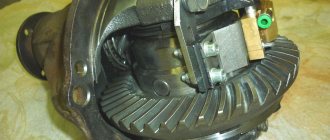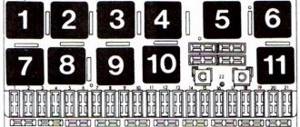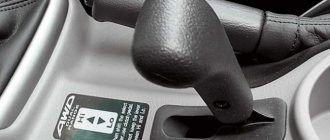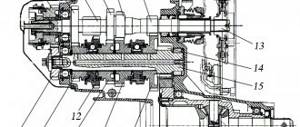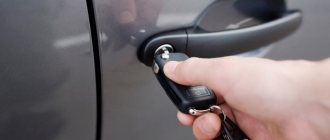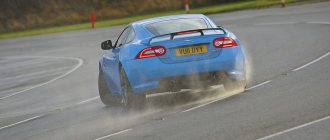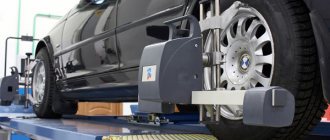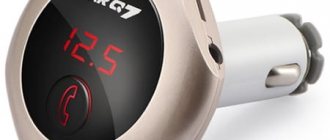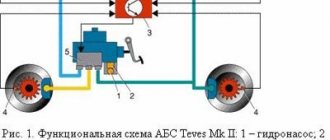One of the most important components of a car’s transmission, which continues to be improved by designers of all the world’s leading automakers and independent developers, is the differential. This mechanism, directly connected to the axle shafts of the drive axle wheels, is “responsible” for transmitting torque to them. Another, no less important function of the differential is to ensure the possibility of asynchronous rotation of the drive wheels, which are forced to take a different path when cornering and driving on a nervous road.
Disadvantages of a free differential and the simplest hard locking systems
Depending on the number of drive axles with which a particular vehicle model is equipped, the differential mechanism can be installed between the wheels (axle differential), as well as between the axles of the vehicle. As, for example, in many SUV models with all-wheel drive. In such cases, this mechanism is called a center differential. Despite the meticulously refined design of the classic “free” differential, this device has one very significant drawback.
A wheel of the drive axle slipping in mud or on ice almost completely takes away the torque from the other wheel, which stops and can no longer move the car forward or backward, despite its confident grip on the road. In addition, SUV owners who are fond of extreme off-road travel are well aware of the situation when, while overcoming difficult obstacles, one of the wheels remains hanging, completely absorbing the engine torque.
Fortunately, almost every driver, even a well-used jeep, has a cross-axle differential lock button at his disposal. Devices for forced braking of the axial rotation of satellite gears connecting the driven gear of the bridge with the axle shafts first appeared on foreign-made SUVs more than 50 years ago. However, differentials with the ability to manually engage rigid interlocking of the drive wheels are also not without drawbacks.
By being forced to rotate at the same speeds, the wheels of the drive axle are capable of moving a car that is slipping on one side on ice or a sticky muddy road. But, if the driver does not turn off this function in time, while driving, hard forced differential locking sharply worsens handling , leads to accelerated tire wear, and causes systematic overloads and probable failure of the most important transmission components. In more modern technical implementations of blocking devices, this problem has been eliminated.
Main types of differential locks
Forced differential locking is carried out using a cam clutch, ensuring a strong connection of the differential housing with one of the axle shafts. It is necessary for the vehicle to overcome difficult-to-pass areas and drive on uneven, shaky surfaces. After passing such a zone, the blocking is turned off. Closing and opening of the clutch is carried out using an electric, hydraulic, mechanical or pneumatic drive. A mechanical drive consists of levers and cables or several levers. You can lock by moving the lever in a certain position on a stationary vehicle. The hydraulic lockable drive includes the main and working cylinders. Electronic differential locking involves closing the clutch using an electric motor. Electronic differential lock xds is a cross-axle differential locking system that operates on the principle of lateral locking using braking. This system can significantly increase the vehicle's traction and make it easier to control. Switching on is done by pressing the corresponding button on the instrument panel. This type of lock is used for all-wheel drive vehicles.
Self-locking disc locking is divided into two types and depends on the different angular speeds of the wheels and the difference in torques. Auto-locking increases disk friction caused by different rotation speeds of the axle shafts. This type of differential is used as a cross-axle differential for sports cars and a center differential for off-road vehicles.
The eds lock is designed to help the car during start-up and acceleration on slippery roads. The arb lock is indispensable on rough terrain when one of the wheels loses traction and spins in vain. In this case, arb provides ideal grip on any surface. To install the arb, you will need a special pneumatic blocker, which will make control several times easier. The arb system does not affect the operation of the vehicle's wheels, tires and transmission at all, without complicating steering. These advantages make this type of locking indispensable, allowing the arb to be used both off-road and in urban conditions.
A locking differential can be installed on any car
Through the efforts of designers and enthusiasts from many countries, more advanced systems have been created in the last decade - both forced and automatically activated systems for distributing torque between the axle shafts of the drive axle. Modern differential lock designs make it possible to ensure stable vehicle maneuverability and controllability even in the most difficult road situations. Now many car models, in particular SUVs, are equipped with a differential with a locking mechanism initially, during the assembly process.
Typically, a rear differential lock is present in almost any rear-wheel drive vehicle designed for off-road use or in regions with long winters and snowy, icy roads. To improve the performance characteristics of some off-road vehicles with two drive axles, manual or automatic locking of the center differential is also provided - a mandatory design element of all such vehicles.
Vehicles whose drive axle was not equipped with such a system at the factory can be modified. To achieve this, various manufacturers offer compatible units designed to replace the standard differential. At many service stations, you can upgrade the rear or front axle of not only any of the popular foreign cars, but also install a differential lock on the Niva, VAZ, UAZ, Gazelle, and other samples of products of the domestic automobile industry.
Like any other technical solutions, all existing locking designs have certain advantages and disadvantages. Before you begin upgrading the transmission of your existing vehicle, it is useful to study the properties and characteristics of all solutions offered by manufacturers. Knowledge of the technical nuances of the differential design of a modern car will help you accurately assess the prospects of the proposed locking solution and make the right choice.
Types of structures
All currently existing interlocking systems for vehicle axle shafts and axles can be reduced to two main types of structures:
● Differentials based on full rigid locking. Experts call this group of mechanisms “lockers” (a borrowed foreign term derived from the English word “lock” - Locker). We have already discussed the disadvantages of such systems.
● Limited slip differentials , otherwise called “limited slip differentials” (English version of the name - Limited Slip Differential).
Based on the type of activation, a distinction is made between “manual” forced differential locking and self-locking structures, which are capable of fully automatically enabling, adjusting or disabling the mutual fixation of the drive wheel axle shafts depending on road conditions.
Additive Suprotek Reducer, in gearboxes and differentials
Restores the shape of teeth in gear transmissions of gearboxes of any type. This reduces noise and vibration during operation of the unit, makes work easier, and extends its service life by 2.5-3 times.
more reviews
Center differential locking mechanisms: what are they?
There are several main groups that differ in their principles. In this case, these groups, in turn, are also divided into subgroups. There is rigid full locking, limited slip differentials, with symmetrical or asymmetrical traction distribution. Viscous coupling belongs to the second and third subgroups at the same time, since disc slippage can be observed in equal driving conditions. It is quite natural that then the traction force will be asymmetrically distributed between the axles. When the most difficult conditions occur, one hundred percent blocking will occur due to complete solidification of the liquid. As for the interaxle shaft locking designs, they can be as follows:
- Viscous coupling;
- Cam clutch;
- Friction clutch;
- Thorsen lock.
Each of them works according to its own principle, but there are still some similarities between them.
What a center differential lock is will be discussed in detail in this video:
Published: September 26, 2020
Design features
All existing technical locking solutions with a manual activation method, which make it possible to force the same speed of rotation of the wheels of the drive axle, are associated with braking the axial rotation of the satellite gears. This function in modern cars is implemented through an electronic differential lock button connected to a winding that actuates a pusher and a locking plate that blocks the rotation of the satellites.
Taking into account the increased load on the transmission, higher fuel consumption and accelerated tire wear during long-term operation of the car with the hard lock turned on, some design options provide for automatic unlocking of the differential when the car reaches a certain speed. Currently, there are many options for “hard” differential locking on the UAZ and Niva, which, if used correctly, can significantly improve the vehicle’s driving capabilities when driving off-road.
Self-locking differentials do not have the disadvantages inherent in forced engagement and release mechanisms. Most well-known and widely used systems of this type are based on four design solutions:
| ● Disc locking mechanism based on one or two friction clutches. More often, mechanisms with two clutches are used, which require pouring special transmission oil into the axle or using special additives. |
| ● Viscous system using a viscous coupling consisting of a group of driven and driven disks. |
| ● Screw locking mechanism - durable system with minimal wear. |
| ● Cam locking system, which does not require special oils and has a long service life. |
There are other designs of self-locking differentials, many of which were created by Russian mechanical engineers. Anyone can find a reliable, functional and cost-effective locking system designed for a specific car model, or use one of the universal designs.
Additive for SUV gearboxes. Suprotek 'Off Road Reducer'
For gearboxes, transfer cases of SUVs and vehicles operating under heavy loads. Restores gearing, which reduces noise and vibration and facilitates the operation of the unit.
more reviews
There are no restrictions! Today, without any problems, you can select and install a differential lock on a VAZ of any model, including even the very first releases, or improve and make a fairly “fresh” SUV even more passable.
